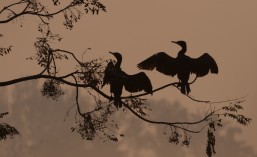Order: Passeriformes Family: Sturnidae Conservation Status: Least Concern
Synonyms: Orange-faced Grackle, Orange-faced Myna, Papuan Myna, Long-tailed Myna
Description:
The Yellow-faced Myna is a large bird measuring 23 to 26 cm in length and weighing around 217 grams.
It has an overall black plumage which has a metallic lustre. There are short spiky feathers on the forehead and at the base of the upper mandible – these have a blue-purple sheen. Most of the head is bare and this bare skin, which forms a patch around and behind the eye along with a bib on the chin and sides of the throat, is orange-yellow. The beak and legs are a similar orange-yellow colour. The iris is yellow to brown. The neck, throat and mantle have a purple metallic sheen, whilst the back, wings, breast and belly have a greenish sheen. The tail is short and squarish. Additionally it has a white rump and under tail coverts with a golden-yellow lower belly.
Call and Vocalisation:
The Yellow-faced Myna is a noisy bird, emitting a variety of “nasal, growling, and croaking calls with a sometimes human-like conversational quality”
Yellow-faced Myna call
Yellow-faced Myna call

